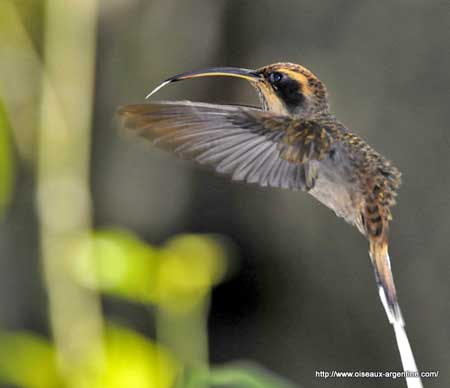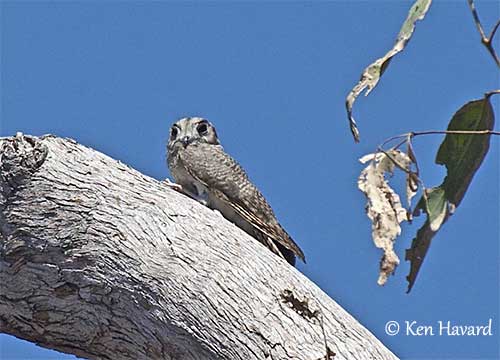
Page under
copyright !
TO BE CONTINUED... Page 13
Text by Nicole Bouglouan
Photographers:
Roger Ahlman
Pbase Galleries Peru and Ecuador
John Anderson
John Anderson Photo Galleries
Jean Michel Fenerole
Photos d’Oiseaux du monde
Steve Garvie
RAINBIRDER Photo galleries & Flickr Rainbirder
Tom Grey
Tom Grey's Bird Pictures & Tom Grey's Bird Pictures 2
Ken Havard
My Bird Gallery & Flickr gallery 1 & Flickr gallery 2
Tom Merigan
Tom Merigan’s Photo Galleries
Pete Moulton
Pete Moulton Photography
Dubi Shapiro
Dubi Shapiro Photo Galleries
Ingo Waschkies
Bird Photography
Philippe et Aline Wolfer
OISEAUX D'ARGENTINE
These images and the text are subject to copyright and cannot be used without express authorization from the owners. Legal issues
Sources :
HANDBOOK OF THE BIRDS OF THE WORLD Vol 5 by Josep del Hoyo-Andrew Elliott-Jordi Sargatal - Lynx Edicions - ISBN: 8487334253
L’ENCYCLOPEDIE MONDIALE DES OISEAUX - Dr Christopher M. Perrins - BORDAS - ISBN: 2040185607
Wikipedia, the free encyclopaedia
Bird nests: Variety is Key for the world’s avian Architects
Be on the lookout for bird nests
The design and function of birds' nests
The bird and its nest, where everything starts…
Page 12: Aegothelidae, Apodidae, Hemiprocnidae and Trochilidae
At the beginning of the breeding season and following several courtship displays, the nest-site is selected by the pair, or one of the members of the pair, and the nest is built within this area. For numerous species, the nest is the place where displays and copulation occur. It plays a very important role during the nesting period. It is the cradle of the chicks, the place where the adults feed them prior to their first flight towards independence.
The family Aegothelidae gathers several birds very similar to owls but also to nightjars and frogmouths, but today, this family is part of the order Apodiformes, following morphological comparative studies. But recently, the IOC World Bird List included this family in its own order Aegothelifornes, since morphological studies of the cranium in the 1960s. Owlet-nightjars are an exclusively Australasian group but they are poorly known.
These small crepuscular birds are insect-eaters. They have a wide bill and open nostrils with well-developed facial bristles. Their plumage is very cryptic with brown, grey and paler colours and dark and white markings overall. The wings are short and fairly rounded and the tail is long and rounded. Legs and feet are rather small, and usually weak. Male and female are similar.
The Australian Owlet-nightjar show longer and more pointed wings and its tail is particularly long. Its legs and feet are stronger too. It is well adapted to more open woodlands than other species, and frequents scrub in arid regions, low shrubland and can be seen feeding in open grassland.

The other owlet-nightjars are mainly forest birds and occur in lowland or mountains, depending on the species. They are secretive nocturnal birds. During the day, they usually roost in tree holes, although some of them also roost in clusters of dead leaves or dark tangles of shrubbery, or on a branch.
They feed on a wide variety of insect species but information on their feeding techniques is lacking. However, the Australian Owlet-nightjar sallies from perches and catches insects in the bill. It swoops onto prey from a low perch and catches it from ground or tree trunks, but is also hunts on the wing, flying low over the ground with rapid and regular wingbeats.
The lack of information makes difficult to describe the breeding habits of owlet-nightjars. Some nests have been found in hollows in dead tree stubs.
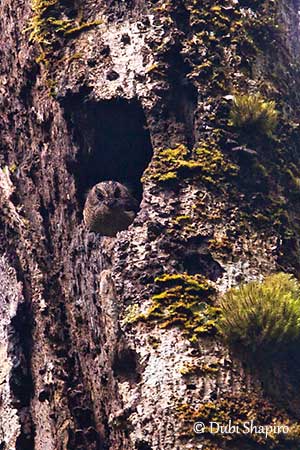
The Australian Owlet-nightjar has been more studied. It nests in holes in trees, sometimes in fence posts and fallen logs, crevices in buildings or even burrows in riverbanks. The nest entrance may be at ground level or up to 20 metres above the ground, but generally mostly between 1 and 5 metres.
The cavity is lined with fresh leaves of Eucalyptus or Acacia or pieces of bark. The 3-4 white eggs are laid on this lining, and the fresh leaves may have insecticidal properties.
Both parents share the nesting duties. The chicks fledge abruptly in the middle of the night, about one month after hatching.
The family Apodidae includes insect-eaters, small to medium-sized birds. These aerial birds have long and narrow wing shape well adapted to the flapping flight, although they prefer to glide. The flight is powerful, thanks to the long flight-feathers. The tail is usually deeply forked but the swiftlets have mainly shallow furcation. However, some species show “spines” or “needles” extending beyond the tips of the rectrices, giving the birds their names. They have short legs but powerful feet, allowing the bird to perch on vertical surfaces.
The swifts have very large gape adapted to their hunting behaviour but the bill is short. The dark eyes are protected by bristle-like, black feathers in front of the eye.
The plumage is usually dull brown to black, but some exceptions such as the Chestnut-collared Swift and the Tepui Swift have a bright chestnut to reddish throat.
Vogelkop Owlet-nightjar
At daytime roost in tree hole
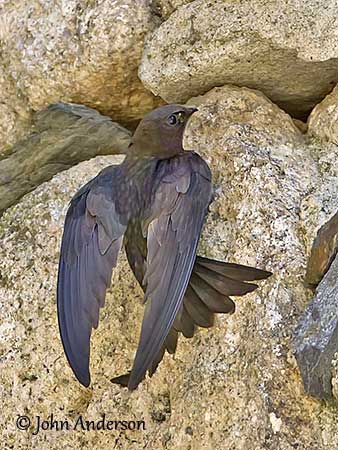
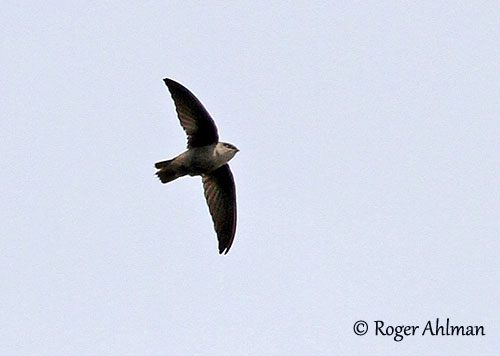
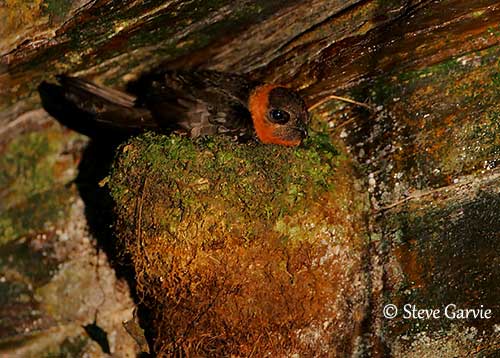
They are widespread throughout the world except for the poles.
They need habitats and water where they can find prey. These birds are usually often well away from their nesting sites and roosts. They feed on numerous species of insects and spiders, taken in the air or while flying close to vegetation, taking prey items from foliage. The size of the prey depends on the size of the gape, avoiding competition for food between them. They regularly drink by flying low over water and skimming the surface with the lower mandible.
The swifts are apparently monogamous with long term pair-bonds, but this may vary according to the species. They breed when insects are abundant. They use a wide range of nesting sites, but most of them are in dark situations. This fact is mainly observed in swiftlets that are able to fly into the total darkness in cave systems.
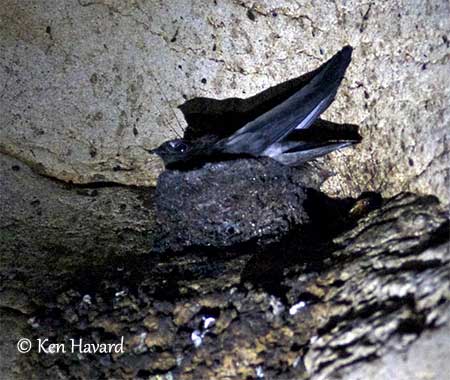
Generally, they need water, safety through inaccessibility, darkness, free flyways in front of the nest (sometimes up to 40 metres long) and clear access to the entrance, rock ledges or niches where they can build the nest and they prefer high relief.
On the other hand, several swift species depend on other birds or plants. Some swifts nest in bee-eater, kingfisher or martin’s colonies. Others may use abandoned nests of swallows or woodpeckers.
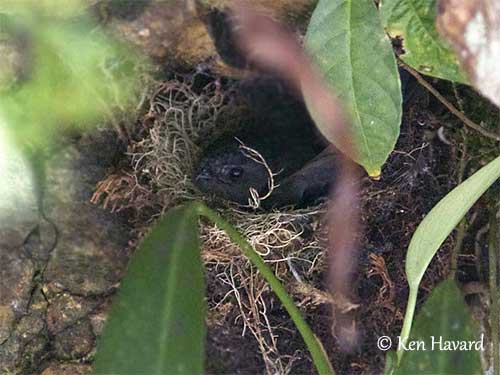
However, the most usual structure is a self-supporting bracket usually attached to a vertical surface or wall. The nest materials are held together, and the nest itself is fixed to the substrate with saliva. In these species, the salivary glands are enlarged during the breeding season, in order to provide sufficient amount of saliva.
Some other types of nests can be found and also different vertical surfaces such as dried palm fronds, palm trunks, roofs and man-made structures.
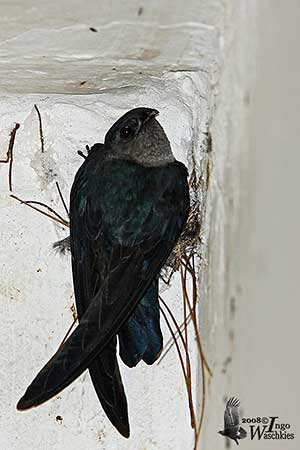
Swifts strongly defend their nests, and fighting may occur following threat displays. The clutches include 1 to 6 white eggs incubated during 17 to 28 days. The young birds fledge between 34 and 72 days after hatching, depending on the species.
The family Hemiprocnidae includes four species of the same genus Hemiprocne. These birds are found in the Oriental region from India and South East Asia, through Indonesia to New Guinea and the Solomon Islands.
The treeswifts are small to medium-sized swift-like birds. They have long wings, and especially long primaries. They differ from Apodidae by softer plumage, and they show facial ornaments and crest. The long tail is deeply forked.
Unlike the swifts, the treeswifts are able to perch on branches, thanks to a non-reversible hind toe.
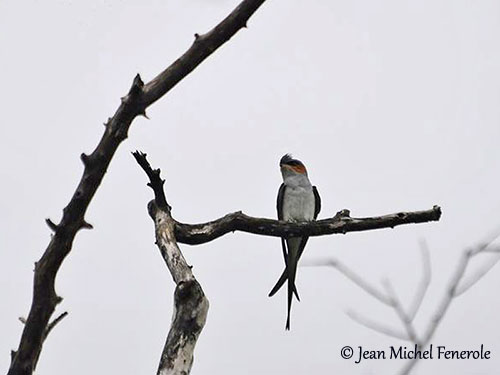
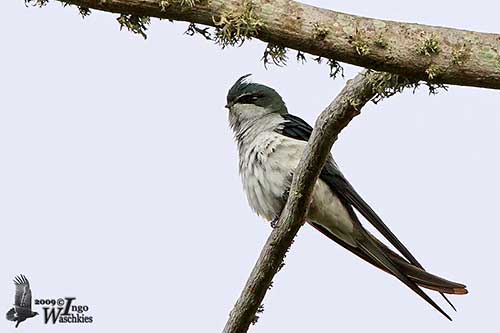
The treeswifts frequent a wide variety of habitats, from primary to humid forests and deciduous woodlands. The Grey-rumped Treeswift can be found in every type of habitat from mangrove to hill forests.
All species feed on insects, but very little is known about their diet. The prey are usually taken on the wing, but the Whiskered Treeswift also picks off food items by perching or hanging from the tip of a small branch. They are often more active after rain that involves insect abundance.
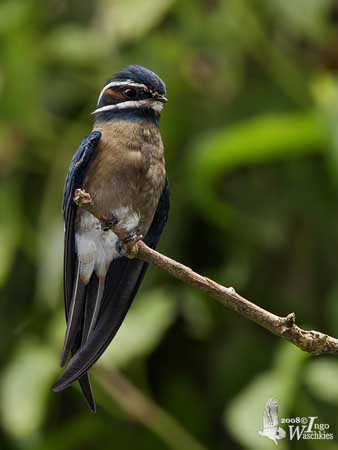
The breeding season is long and takes place in spring and/or early summer. Both mates share the nest building. Like the Apodidae, they use their saliva to hold the materials together.
The size of the nest depends on the species, but it is generally small and usually placed off the side of narrow, bare twig. This situation gives the birds an access in several directions. In addition, the thinness of the twig allows to detect the approach of some snake or other climbing predator. There is a rim around the cup, made with thin pieces of bark, feathers and other fragments of plants, held together with saliva. The very small nest is just large enough to contain a single egg. This structure is easily seen like a part of the branch.
The female lays a single white to pale grey egg. The incubation may last about three weeks and the chick leaves the nest within one week after hatching. Both parents feed the young with regurgitated food.
The family Trochilidae gathers more than 300 species of Hummingbirds, and it is one of the largest families of the New World where they can be found in Neotropical regions. This family includes hummingbirds and hermits (genus Phaetornis).
Hummingbirds are very small birds of only some grams, but these birds are unique by their flight, their behaviour, and their ability to enter hypothermic torpor in order to conserve the energy during the night.
They are the perfect example showing that size is not very important in the wild. The main goal is to survive and Hummingbirds, in spite of habitat loss in several areas, are very strong bird species.
Hummingbirds are small birds. The long, thin bill may have different shapes, according to the feeding behaviour. Their specialized and sensitive tongue allows them to reach the nectar which is their preferred food.
They have very short legs and they are unable to walk or hop on the ground. But their wings are very well adapted to the hovering, necessary for feeding. Hummingbirds are very agile in flight. When feeding on nectar, the bird is able to hover forwards and backwards.
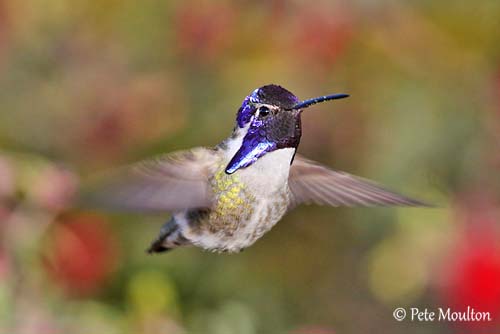
They have iridescent feathers, often on head and throat, but other parts of the body may have glossy feathers. The plumage coloration is closely related to the behaviour. Females always are duller than males, and exhibit more cryptic colours, very useful at nest-site.
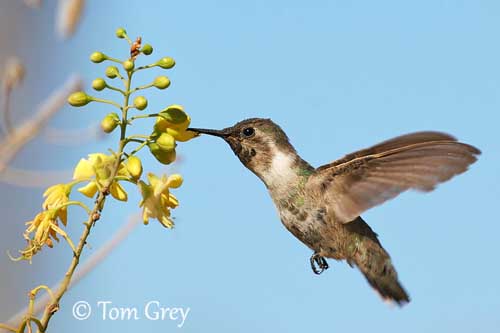
Female
Hummingbirds defend strongly their food sources. Nectar is the largest part of their diet. Their preferred food plants bear fairly large flowers, solitary or in clusters, in horizontal or pendent position. These flowers are opened by day and are usually brightly coloured, yellow, red or orange. They frequent a wide variety of habitats closely related to food resources.
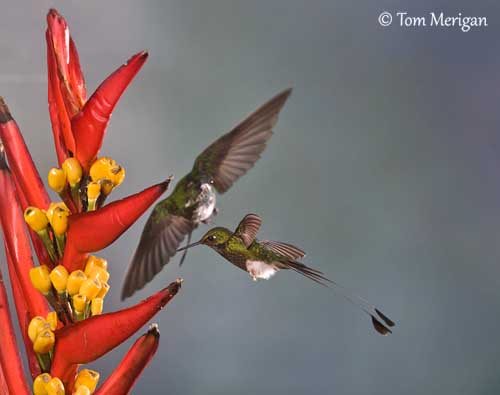
In Trochilidae, males are polygamous and mate with several females. They do not take part to nesting duties. The female builds the nest, incubates her eggs and rears the young alone.
The courtship displays of the males include songs, exposition of the iridescent plumage and flight displays at leks. This behaviour for attracting females is similar to the defence displays.
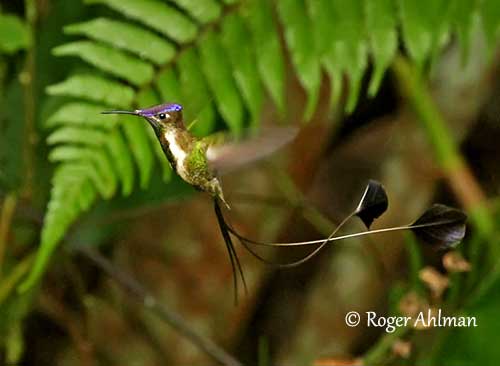
The tiny nest is often situated in branches with leaves or palms to which she attaches the nest, or glued to rocky walls, hidden among vegetation and even fastened beneath a hanging leaf which shelters the nest from the rain.
The small nest is cup-shaped, and may be domed or semi-domed. The exterior is decorated with lichens, moss, leaves and pieces of bark providing an excellent camouflage. Spider webs are often added for binding together all the materials. The interior is lined with soft, finer plant materials, feathers or animal hair.
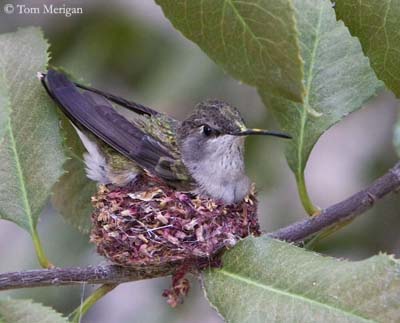
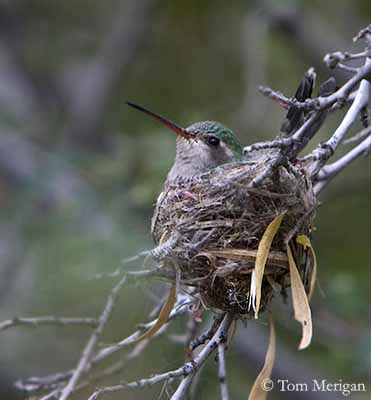
The female usually lays two white eggs and incubates during 16-19 days, but the incubation may vary from 14-16 to 22-23 days, according to the species.
The altricial chicks hatch almost naked and blind. The nesting period lasts 23 to 26 days (up to 30-40 days in high Andean Trochilids).
Two chicks at nest
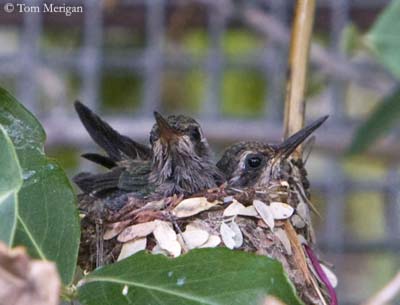
The hermits of genus Phaetornis slightly differ in plumage, with a peculiar head pattern. The crown is flat, and there are two pale facial stripes contrasting with a dark mask. The long, decurved bill is well-adapted for collecting nectar from large flowers such as Heliconia. They also take insects and spiders from foliage and spider webs, but to a lesser degree.
The feeding territory is defended by both male and female like in hummingbirds, but they are usually less aggressive. They remain mainly at dark, lower level of the forests and along streams where they can find their food. They are mainly found at forest edge and in undergrowth, although some species may occur in more open areas.
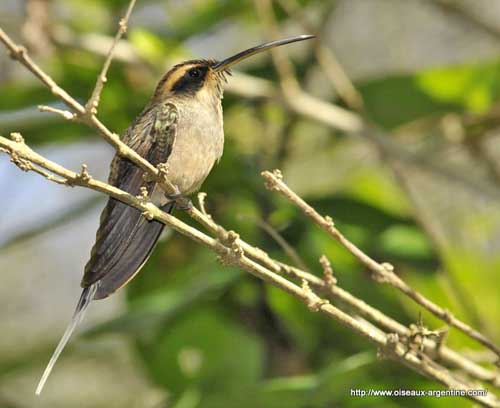
The males gather at leks where they display and sing loudly to attract females. The females choose the best singers and mate with them.
The nest is made with plant materials and cobwebs. It is attached to the inner tip of a palm leaf, fern or Heliconia. This is a compact, conical, pendent nest made with vegetal fibres bound with spiders’ webs. It is decorated with Spiloma. This lichen often releases red pigment on female’s belly, involving a pink coloration on the eggs.
The female lays two eggs, and incubates during 17 days. The young fledge about three weeks after hatching.
